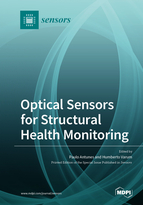Optical Sensors for Structural Health Monitoring
A special issue of Sensors (ISSN 1424-8220). This special issue belongs to the section "Optical Sensors".
Deadline for manuscript submissions: closed (30 June 2020) | Viewed by 62025
Special Issue Editors
Interests: optical fiber sensors; e-Health platforms; structural health monitoring; biosensing
Special Issues, Collections and Topics in MDPI journals
Interests: earthquake engineering; structural analysis and design; structural health monitoring; finite element modeling and analysis; building codes; nonlinear analysis; construction engineering; structural optimization; building materials; construction materials; protection of cultural heritage; structural engineering; seismic design; cultural studies; conservation and restoration of cultural heritage; structural reliability; civil engineering materials adobe; nondestructive testing; sustainable construction; civil engineering technology; construction technology; life-cycle assessment; reinforced concrete buildings; masonry buildings
Special Issues, Collections and Topics in MDPI journals
Special Issue Information
Dear Colleagues,
The evolution and need for preservation and maintenance of existing structures, recent or historical, has fostered research in the area of structural monitoring, translated into the development of new techniques, equipment and sensors. Early detection of damage and accurate assessment of structural safety requires monitoring systems, the data of which can be used to calibrate numerical models for structural analysis and to assess their safety. Data are obtained under real time conditions, considering a group of parameters related to structural properties, such as stresses, accelerations, deformations and displacements. The analysis of the structural properties is particularly relevant when the structure is subjected to extreme events (earthquakes, wind, fire, explosions, among others) or by repeated loads (road/rail/air traffic, vibrations induced by equipment and machines), since they affect the structural integrity, and put at risk the users. In order to prevent the severe damage and eventual collapse of the structures, and consequent human, material and economic losses, the implementation of monitoring systems becomes a valuable tool for today's society.
Monitoring of structures is becoming increasingly important, not only as preventive actions, but also due to the actual economic and sustainability concerns, to ensure a safer and more comfortable built environment. Identifying structural damage and monitoring its evolution requires the development of sensing and structural monitoring techniques. Within these detection technologies arise the optical sensors, which have advantages such as immunity to electromagnetic interference, high sensitivity, reduced size and mass and minimal aesthetic invasion.
This Special Issue will focus on the current state-of-the-art of optical sensors for Structural Health Monitoring (SHM), covering recent technological improvements in new devices/sensors and emerging applications. Both original research papers and review articles describing the current state-of-the-art in this research field are welcome. Editors intend with this SI provide an overview of the present status and a future perspective of the aforementioned topics.
The manuscripts should cover, but are not limited to, the following topics:
- Physical, chemical, and environmental optical sensors for SHM;
- Interferometric and polarimetric sensors;
- Nano- and micro-structured fiber sensors including fiber gratings and photonic crystal fibers;
- Multiplexing and sensor networking;
- Distributed sensing;
- Advances in interrogation techniques for optical sensing;
- Smart structures and sensors;
- Bragg gratings, Fabry Perot cavities, and plasmonic and Mach Zehnder interferometers;
- SHM case studies using optical technologies;
- Low-cost, miniaturized, and selective and multiparameter optical devices;
- Energy-efficient SHM integrated platforms;
- Big data analysis for SHM;
- SHM advanced signal processing techniques.
Dr. Paulo Antunes
Prof. Dr. Humberto Varum
Guest Editors
Manuscript Submission Information
Manuscripts should be submitted online at www.mdpi.com by registering and logging in to this website. Once you are registered, click here to go to the submission form. Manuscripts can be submitted until the deadline. All submissions that pass pre-check are peer-reviewed. Accepted papers will be published continuously in the journal (as soon as accepted) and will be listed together on the special issue website. Research articles, review articles as well as short communications are invited. For planned papers, a title and short abstract (about 100 words) can be sent to the Editorial Office for announcement on this website.
Submitted manuscripts should not have been published previously, nor be under consideration for publication elsewhere (except conference proceedings papers). All manuscripts are thoroughly refereed through a single-blind peer-review process. A guide for authors and other relevant information for submission of manuscripts is available on the Instructions for Authors page. Sensors is an international peer-reviewed open access semimonthly journal published by MDPI.
Please visit the Instructions for Authors page before submitting a manuscript. The Article Processing Charge (APC) for publication in this open access journal is 2600 CHF (Swiss Francs). Submitted papers should be well formatted and use good English. Authors may use MDPI's English editing service prior to publication or during author revisions.








